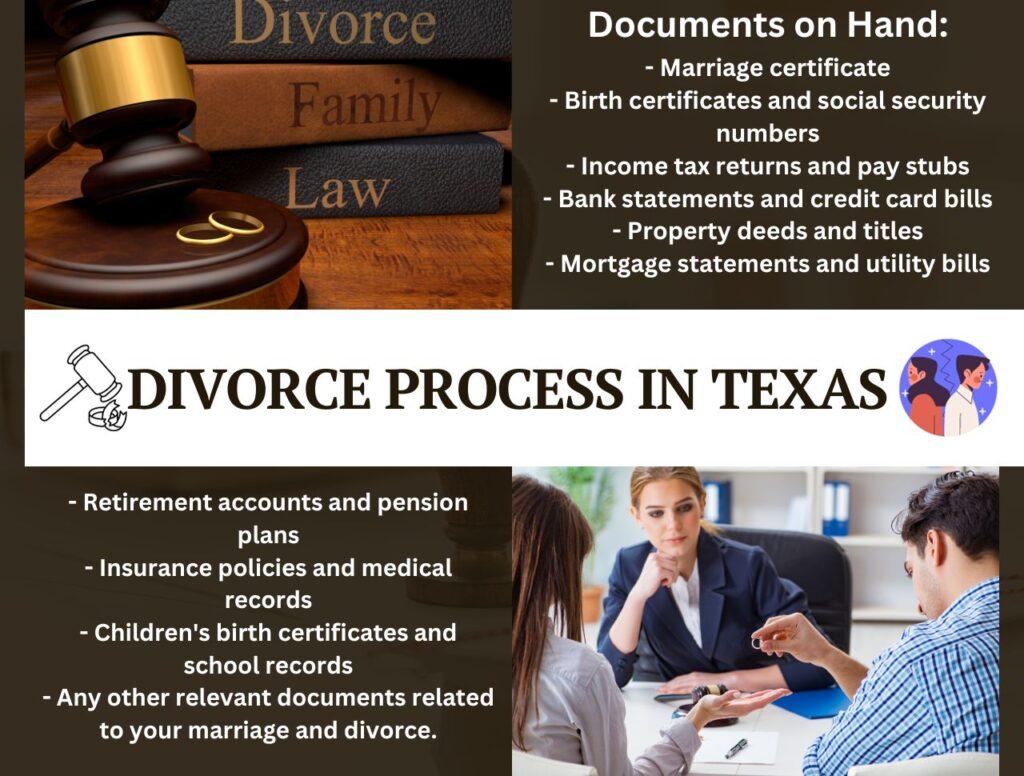Divorce is a major event that comes with complex feelings and legal issues. Divorce in Texas is a legal process that can be initiated by either spouse when the marriage has become insupportable due to discord or conflict. The state allows for both no-fault and fault-based divorces, with the former being more common.
Filing for divorce in Texas without a lawyer, also known as a pro se divorce, is a more affordable option for couples who are willing to work through the process on their own. Its goal is to clarify legal steps and equip individuals with the confidence and resources needed to handle their own divorce cases.
Types of Divorce in Texas
Before filing for divorce in Texas, must understand the types of divorce in texas. The two types of divorce in Texas:
- Uncontested
- Contested.
An uncontested divorce occurs when both spouses reach an agreement on all major aspects of the divorce, including how to divide property, who will take care of the children, the amount of child support, and alimony arrangements.
A contested divorce happens when spouses do not agree on one or more important matters and require a court’s decision. On the other hand, an uncontested divorce tends to be quicker, less costly and simpler than a contested one.
How to File for Divorce in Texas without a lawyer?
Divorce in Texas Without a Lawyer is a cost-effective choice that demands familiarity with legal protocols. The process involves several key steps:
Meet the Texas Residency Requirements
Both uncontested and contested divorces share identical residency requirements in Texas. Eligibility for filing a divorce necessitates that one spouse has been a resident of the state for a minimum of six months and has also lived in the county of filing for at least 90 days prior to the submission of the divorce paperwork. This ensures that the legal process is adhered to within the jurisdiction where the divorce is sought.
Filing for Divorce
Initiating a divorce in Texas begins with the submission of an Original Petition for Divorce at the District Clerk’s Office in the local county courthouse.The process involves several steps:
- Start by filing an Original Petition for Divorce at the District Clerk’s Office in the local county courthouse.
- Obtain the petition form from the district clerk’s office in the county where one of the spouses lives.
- Complete the form with all required personal information.
- Sign the form in front of a notary public.
- Make two copies of the signed form.
- Pay the filing fee, usually around $300, to the clerk.
- Receive a case number and filing date stamp on the copies from the clerk.
- Keep a copy of the form for personal records.
Serving the Divorce Papers
Once the Original Petition for Divorce is filed, it is essential to ensure the other spouse receives the documents, which include a citation, a waiver of service, and a notice of service. The citation informs them of the divorce and outlines their rights and responsibilities, while the waiver allows them to forego formal service. The notice of service confirms delivery. There are several methods to serve these papers:
- Personal service: A sheriff, constable, or private process server is engaged to deliver the documents directly. This method is highly reliable but may incur additional costs and time.
- Certified mail: The documents are sent via certified mail, requiring a return receipt. This option is more economical, though potentially less dependable.
- Publication: If the spouse cannot be located after diligent search efforts, the documents may be published in a public medium, such as a newspaper. This method is used as a last resort and requires court approval and a waiting period after publication.
These procedures are necessary as they provide the other spouse with the opportunity to be informed about the divorce proceedings and to respond. The process ensures that all legal service requirements are met within the jurisdiction of the court.
Responding to the Divorce Petition in Texas
Upon receipt of the divorce papers, the other spouse is allotted 20 days plus the subsequent Monday to submit a formal response to the court. This response indicates their agreement or disagreement with the divorce petition and whether any counterclaims or defenses are presented. The nature of the response determines the course of the divorce:
- Answer: Signifies agreement with the petition without any counterclaims or defenses, indicating an uncontested divorce, allowing the process to move towards finalization.
- Answer and Counter-Petition: Reflects disagreement with parts or the entirety of the petition, accompanied by separate claims or requests, leading to a contested divorce that requires resolution of disputes prior to finalization.
- Waiver of Service: Occurs when the other spouse chooses to forego the formal service process and consents to the petition, suggesting an uncontested divorce and enabling progression towards completion.
Negotiating a Settlement Agreement
In cases of uncontested divorce or when aiming to circumvent a contested one, negotiating a settlement agreement is advisable. This document delineates the division of property, debts, assets, liabilities, and arrangements for children’s custody, visitation, support, and alimony.
A settlement agreement is beneficial as it can conserve time, resources, and reduce stress by bypassing a trial, granting greater control over the divorce outcome. Various negotiation methods are available:
- Direct negotiation: Involves direct communication between spouses to agree independently. While being the most straightforward and cost-effective, it can also present complexities and risks in high-conflict situations or intricate matters.
- Mediation: Engages a neutral mediator to assist in reaching an agreement. The mediator facilitates dialogue and problem-solving without making decisions. This method offers a more formal and guided approach, albeit potentially more costly and lengthy.
- Collaborative law: Involves each spouse hiring attorneys committed to a cooperative process to achieve an agreement, with an understanding that these attorneys will not represent them in court should negotiations fail. This approach encourages support and creativity.
Complete the Final Decree of Divorce Form
Upon reaching a mutual understanding, the agreement should be formalized in writing, notarized and attached to the final divorce decree. This ensures that the agreed-upon terms are legally binding.
The definitive measure of an uncontested divorce is the spouse’s consent, as evidenced by their signature on the Final Decree of Divorce, which encompasses all essential points such as asset distribution and child support.
In a community property state like Texas, division of assets and debts is expected to be equitable, though certain exceptions, such as inheritances, may remain the sole property of one individual.

Waiting Period
In Texas, a mandatory waiting period of 60 days is required from the date the divorce petition is filed before the divorce can be finalized and officially granted by a judge. This waiting period begins the day after the petition is filed.
Exceptions to the 60-day waiting period (where a divorce may be granted immediately by a judge) include:
- If there is an active protection order or magistrate’s order for emergency protection against one spouse.
- If one spouse has been convicted or received a deferred adjudication for a crime related to family violence.
These exceptions are in place to address situations where immediate legal action may be necessary for the protection of individuals involved.
Go to Court
Following the mandatory 60-day period, the initiating party may proceed to court to finalize the divorce terms. Should both parties and the judge concur with the divorce terms and the submitted forms, only the initiating party’s presence is required at the hearing.
During this session, the judge will verify certain fundamental details regarding the marriage and its dissolution, necessitating the signing of documents by the initiating party. Honesty is imperative, as any deception or misrepresentation is considered a criminal offense.
If any disputes arise, an adversarial hearing will be convened where both parties may present their case with legal representation, evidence, and witnesses. Later, the judge will render a final written decree, thereby formally concluding the marriage once all matters are settled.
File Final Decree of Divorce with Judge’s Signature
The final phase involves the formal submission of the necessary paperwork to the court clerk. The essential documents typically cover,
- Original Petition for Divorce
- Respondent’s Original Answer or Waiver of Service
- Final Decree of Divorce with the judge’s signature
Should there be minor children involved, supplementary documents may be required. Upon the filing of these documents, the divorce becomes legally binding. This marks the successful conclusion of the procedure.
Duration to File for Divorce in Texas?
The duration to finalize a divorce in Texas can differ greatly such as,
- Mandatory Waiting Period: Texas law requires a 60-day waiting period after filing the divorce petition.
- Uncontested Divorce: If both parties agree on all terms, the divorce could be finalized as quickly as a few months after the waiting period.
- Contested Divorce: Disputes over issues like child custody or property division can extend the process to several months or even years.
- Default Divorce: If one spouse does not respond to the divorce petition, the process duration depends on court processing times.
- Collaborative Divorce: This cooperative approach may take longer than an uncontested divorce but is often faster than a contested one.
A divorce in Texas might take anywhere from six months to a year, with simple uncontested cases potentially being resolved in just a few months, while contested cases could take much longer

How Much Does It Cost to File for Divorce in texas?
In Texas, the filing fees for divorce proceedings vary by county, falling between $150 and $350. Specifically, Harris County charges $320 when children are involved and $293 otherwise. Dallas County’s fees stand at $401 with children and $350 without.
These amounts cover only the court filing and exclude other expenses like legal representation, document duplication, and various ancillary services.
Also, Read Filing for Divorce in California Without a Lawyer: Step-by-Step Guide






